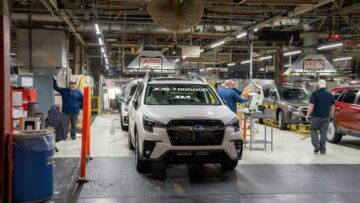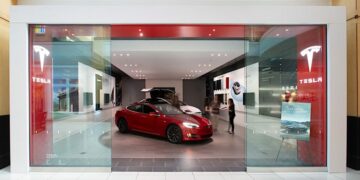While some figures such as Elon Musk are predicting a steep recession, no downturn is in sight in the car business as sales of new vehicles are continuing to hold steady as inventories and incentives remain at modest levels, according to analysts.

Thomas King, president of the data and analytics division at J.D. Power, noted, “Retail inventory in December is expected to finish its third consecutive month at more than 1 million units. With the improving inventory levels, December total sales volume will be up from a year ago, however there are still not enough vehicles produced to meet demand.”
Full year sales drop but demand remains strong
Full year 2022 will show a total sales decrease from 2021 due to production constraints, noted J.D. Power’s analysts.
“The year-over-year sales increases experienced for the final five months of 2022 were not enough to offset the year-over-year sales declines in the first half of 2022 which are compared with the record sales pace in the first half of 2021,” according to a joint forecast from J.D. Power and LMC Automotive.
The forecast noted pricing and per unit profitability will achieve record levels for full-year results. Overall, despite limited production constraining sales volume, the industry is closing out the year with strong underlying financial results.
“Looking at 2023, retail sales will continue to be dictated by the number of vehicles shipped to dealerships. Indications are that shipments will rise incrementally throughout the year, allowing sales to increase from 2022 levels. However, even with the probability of an economic downturn, pent-up consumer demand from the past two years will keep inventory levels relatively low. Therefore, 2023 is likely to be another year of relative healthy pricing and profitability,” the joint forecast said.

Transaction prices will hit a record high for the month even with shoppers becoming a bit more sensitive to retailer markup addendums over MSRP. The reduction in markups is pushing dealer profits off their record high levels, however, per-unit profitably is still nearly double pre-pandemic levels, the forecast said.
Supplies remain tight
While the inventory situation has improved modestly in the fourth quarter, supply remains well below the level at which consumer demand for new vehicles can be met. New-vehicle transaction prices continue to rise — albeit at a slower pace than earlier this year.
“The average price in December will set a record of $46,382, an increase of 2.5% from a year ago,” according to King, who added buyers are expected to spend nearly $48.2 billion on new vehicles this month — the third highest level ever for the month of December and a slight 0.3% decrease from December 2021.
“Dealerships are continuing to pre-sell a good portion of their available inventory allocation, but increased production means vehicles are spending slightly more time at dealerships. This month, 47% of vehicles will be sold within 10 days of arriving at a dealership, down from a high of 57% in March. The average number of days a new vehicle is in a dealer’s possession before being sold is on pace to be 23 days — up from 18 days a year ago.
Manufacturer discounts are up slightly from a month ago, however, they remain historically suppressed. The average incentive spend per vehicle is tracking toward $1,187, a decrease of 21.4% from a year ago during what in recent years a key month for sales promotions.
Incentive spending per vehicle expressed as a percentage of the average vehicle MSRP is trending at 2.5%, down 0.8 percentage points from December 2021. One of the factors contributing to the low level of spending is the absence of discounts on vehicles that are leased. This month, leasing is accounting for just 18% of retail sales. In December 2019, leases accounted for 30% of all new-vehicle retail sales.
Used-vehicle prices are falling modestly which is resulting in less trade-in equity for new vehicle buyers. The average trade-in equity for December is trending toward $9,316, a 3.1%, or $297, decrease from a year ago and down $786 since the peak in June 2022. For context, December 2022 trade equity is still more than double the pre-pandemic level helping consumers that have a vehicle to trade in offset some of the pricing and interest rate increases.
- SEO Powered Content & PR Distribution. Get Amplified Today.
- Platoblockchain. Web3 Metaverse Intelligence. Knowledge Amplified. Access Here.
- Source: https://www.thedetroitbureau.com/2022/12/new-vehicle-sales-remain-steady-in-december/
- 1
- 10
- 2019
- 2021
- 2022
- a
- above
- According
- Accounting
- Achieve
- added
- All
- allocation
- Allowing
- Analysts
- analytics
- and
- Another
- arriving
- automotive
- available
- average
- becoming
- before
- being
- below
- Billion
- Bit
- business
- buyers
- Buying
- car
- closing
- compared
- consecutive
- constraints
- consumer
- Consumers
- context
- continue
- continuing
- contributing
- data
- Days
- December
- december 2021
- Declines
- decrease
- Demand
- Despite
- discounts
- Division
- double
- down
- DOWNTURN
- Drop
- during
- Earlier
- Economic
- economic downturn
- Elon
- Elon Musk
- enough
- equity
- Even
- EVER
- expected
- experienced
- expressed
- factors
- Falling
- Figures
- final
- financial
- First
- Forecast
- Fourth
- from
- from 2021
- good
- Half
- healthy
- helping
- High
- highest
- historically
- Hit
- hold
- However
- HTTPS
- improved
- improving
- in
- Incentive
- Incentives
- Increase
- increased
- Increases
- indications
- industry
- interest
- INTEREST RATE
- inventory
- Keep
- Key
- King
- leasing
- Level
- levels
- likely
- Limited
- Low
- March
- mark
- max-width
- means
- Meet
- million
- Month
- months
- more
- Musk
- nearly
- New
- noted
- number
- offset
- ONE
- overall
- Pace
- past
- Peak
- percentage
- plato
- Plato Data Intelligence
- PlatoData
- points
- possession
- power
- predicting
- president
- price
- Prices
- pricing
- Produced
- Production
- profitability
- profits
- Promotions
- Pushing
- Quarter
- Rate
- recent
- recession
- record
- relatively
- remain
- remains
- resulting
- Results
- retail
- Retail Sales
- retailer
- Rise
- ROW
- Said
- sales
- Sales Volume
- sensitive
- set
- shipped
- show
- Sight
- since
- situation
- sold
- some
- spend
- Spending
- steady
- Still
- strong
- such
- supply
- The
- the joint
- their
- therefore
- Third
- this year
- throughout
- time
- to
- Total
- toward
- Tracking
- trade
- trade-in
- transaction
- trending
- underlying
- unit
- units
- vehicle
- Vehicles
- volume
- What
- which
- WHO
- will
- within
- year
- years
- zephyrnet













